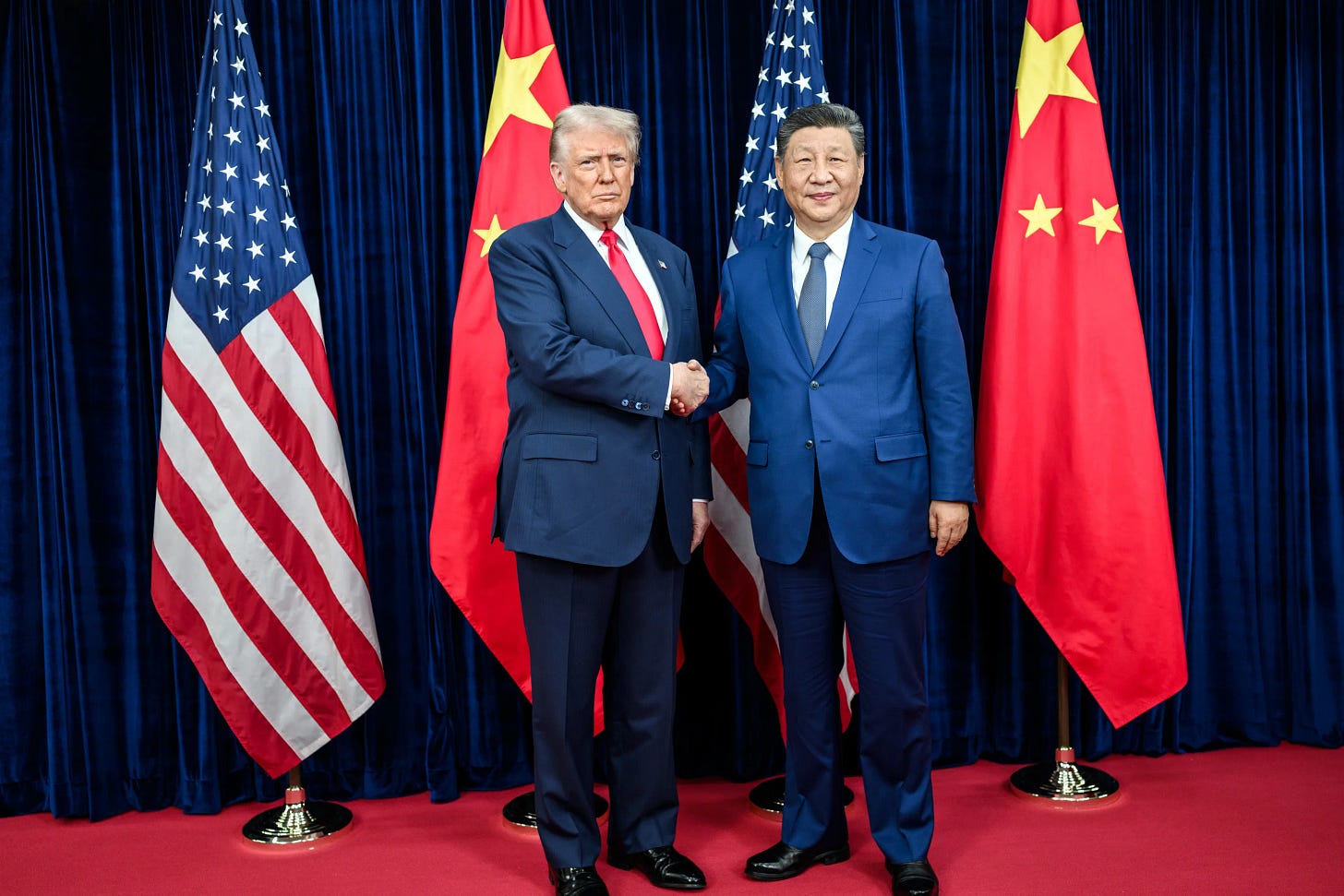The art of the long game
The self-proclaimed master of the deal just got schooled in strategic patience
Greetings from Palo Alto, where I just spend the week at Stanford University. More on that next week. In the meantime, I wanted to share some thoughts on President Trump’s meeting yesterday wtih Chinese President Xi Jinping.
The real headline is that the two leaders backed down from an escalating trade war - and that is a good thing.
Trump called the nearly two-hour discussion “amazing” where the two leaders “agreed to almost everything.”
Here’s what actually happened: Xi Jinping walked into that South Korea meeting with leverage Trump either underestimated or never saw coming, and Beijing played it like a master class in strategic patience.
The surface details look like classic Trump deal-making. The United States committed to slashing fentanyl-related tariffs from 20% to 10%, with overall tariffs on Chinese goods dropping from 57% to 47%. In exchange, China agreed to pause - note that word, pause - the export controls on rare earths it had slapped down just three weeks earlier.
For a president who built his brand on the “Art of the Deal,” this should have been his moment. Except Xi Jinping had spent decades studying how to manipulate American presidents, and Trump had just given him exactly what he wanted: rehabilitation on the world stage and proof that economic coercion works.
Let’s talk about why rare earths matter, because until this trade war, most Americans had never heard of dysprosium or europium - elements with names that sound like rejected Harry Potter spells. These 17 obscure minerals are the invisible backbone of modern technology: smartphones, electric vehicles, weapons systems, renewable energy infrastructure. China doesn’t just mine them - it controls roughly 70% of global production and processes nearly 90% of the world’s supply.
This isn’t an accident. While America was busy outsourcing manufacturing and declaring victory in the Cold War, Beijing was playing the long game, systematically building dominance in materials they knew the world couldn’t live without. It’s the kind of strategic thinking that makes American short-term political cycles look like amateur hour.
Three weeks before the summit, China announced expanded export controls that didn’t just restrict Chinese rare earth exports - they went full extraterritorial, requiring licenses even for magnets containing trace amounts of Chinese-processed rare earths, regardless of where those magnets were made. The message was clear: We own this supply chain, and we’re not afraid to weaponize it.
The impact was immediate. Ford shut down production at its Chicago plant. European automakers reported supply disruptions. Trump was in the middle of his Asia tour, frantically signing deals with Australia, Malaysia, and Japan to diversify America’s mineral supplies - agreements that might matter in five or ten years but did nothing for the immediate crisis.
Xi’s timing was calculated and ruthless. He was willing to risk blowing up the Trump meeting entirely, which tells you everything about his confidence.
Here’s where Trump’s dealmaker instincts actually worked against him. He walked into Busan needing a win to cap his Asia tour. He’d spent days talking tough about demanding concessions, threatening consequences if China didn’t play ball. Xi knew this - and offered Trump exactly enough to claim victory while giving up almost nothing Beijing couldn’t reverse tomorrow.
The one-year pause on export controls? That’s not a concession - it’s a leash. China can reimpose those restrictions any time Washington does something Beijing doesn’t like. Xi now holds a reset button he can press whenever Trump gets too aggressive.
The promises on soybeans and fentanyl? We’ve heard this song before. During Trump’s first term, China committed to purchasing $200 billion more in American goods by 2021. They fell dramatically short. Beijing pledged fentanyl cooperation then too. The flow of precursor chemicals never stopped. Just before this summit, China’s COFCO bought about 180,000 metric tons of soybeans - a fraction of normal volumes - while Trump trumpeted “tremendous amounts” of agricultural purchases.
Even the tariff reductions- which Trump sold as evidence of progress - leave overall rates at 47%, still historically astronomical.
China successfully used economic coercion to force American concessions, proved it can inflict pain on U.S. industry and global supply chains whenever it chooses, and got Trump to accept a temporary reprieve as a permanent victory.
Trump’s aggressive deal-making across Asia - securing agreements with Australia, Malaysia, Pakistan, and Japan – is something and might eventually matter. But experts say building alternative supply chains will take years, possibly decades. The challenges are brutal: high energy costs, worker shortages, environmental concerns, and the risk that China could strategically crash prices to kill competing projects before they’re viable.
Until those alternatives exist, China retains decisive leverage. And Xi has demonstrated he’s willing to use it.
The real test of this “amazing” agreement will come in the months ahead: Will China actually follow through on agricultural purchases? Will fentanyl cooperation produce results? Will the one-year rare earths pause be extended, or will Xi use the threat of renewed controls to extract more concessions?
Trump may have gotten his headlines and his photo op with Xi. But Beijing got something more valuable: confirmation that America’s vaunted dealmaker can be outmaneuvered by patient, strategic economic coercion. In the high-stakes game of U.S.-China relations, this meeting may be remembered as the moment China proved it was ready to pull its weight - and showed just how effective that strategy could be.



